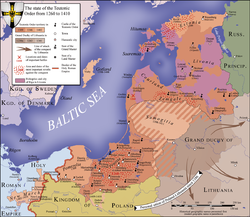| Symbol | Name | Founded | Founder | Origin | Recognition | Protection | Extinction | Notes |
|---|
 | Order of Saint James of Altopascio | 1075
(1084) | Matilda of Tuscany | Altopascio, Tuscany, Holy Roman Empire | 1239–1459,
but mentioned in a Papal bull 1198 of Pope Innocent III | Properties of the hospice of "Altopassus" in Italy confirmed in 1244 by Emperor Frederick II | 1459,
1587,
1672 | Primarily provided safety and protection to Italian pilgrims to the Holy Land and Camino de Santiago. Merged with the Order of Saint Stephen in 1587 by Pope Sixtus V at request of Grand Duke of Tuscany. In France absorbed into the Order of Saint Lazarus in 1672. |
 | Military Order of Monreal [ es ] | 1124 | King Alfonso the Battler | Monreal del Campo, Aragon | | | 1143
1150 | |
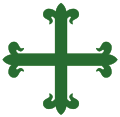 | Order of Aviz | 1176
| | (Évora)Avis, Portugal | | House of Aviz: 1385–1580 | 1789 | Secularised 1789. Statutes revised repeatedly together with the other Portuguese orders of merit, during the First Republic (1910–1926), then in 1962, and again in 1986. |
 | Order of Saint Michael of the Wing | 1147
(1171)
(1828/
1848/
1986) | King Afonso I of Portugal | Santarém, Portugal | First statutes approved in 1171 by Pope Alexander III | House of Braganza: 2001- | 1732 | Abandoned by 1732, [22] restored [23] by King Miguel I in 1828 [24] during his brief rule before losing the Liberal Wars to his brother King Pedro IV, [25] revived 1848 [23] /1986 [26] |
 | Order of Calatrava | 1158 | Raymond of Fitero | Calatrava la Vieja, Kingdom of Castile, Spain | 1164 by Pope Alexander III | House of Bourbon | 1838 by secularisation | King Charles III of Spain requested old orders to contribute to his new order in his name (1775), which led to dissolution. Confiscated by King Joseph (1808), re-established by Ferdinand VII at the Restoration (1814). Secularised in 1838. |
 | Order of the Holy Ghost | 1161 | Guy de Montpellier | Provence, France | ca. 1161–June 16, 1216 by Pope Innocent III in Santo Spirito in Sassia, Rome | | 1692/
1700/
20th century | Historically both religious and chivalric. In 1692 in France, King Louis XIV merged it with his own Order of Our Lady of Mount Carmel. The remaining organisation was edicted in 1700 as purely religious order. [27] Offshoots of the order in France survived into the 20th century. |
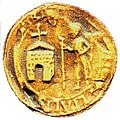 | Order of Aubrac | 1162 | | Aubrac, France | | | 18th century | Disappeared during the French Revolution in late in the 18th century. |
 | Order of Santiago | 1170 | | León or Uclés in Castile, Spain | By Papal bull 5 July 1175 by Pope Alexander III | House of Bourbon | | |
 | Order of Alcántara | 1177 | | Alcántara, Extremadura, Spain | | | | |
 | Order of Mountjoy | 1180 | | Holy Land | | | 1221 | Merged into the Order of Calatrava. |
| Order of Truxillo | before 1188 | | Trujillo, Cáceres | | | 1195 | |
 | Hospitallers of Saint Thomas of Canterbury at Acre | 1191 | William, Chaplain to the Dean | Acre, and England | | | 1538 | |
 | Order of Monfragüe | 1196 | | | | | 1221 | Merged into the Order of Calatrava. |
 | Order of Sant Jordi d'Alfama | 1201 | | | | | 15th century | Early 15th century, merged into the Order of Montesa. |
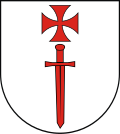 | Livonian Brothers of the Sword | 1202 | | | | | 1236 | Merged into the Teutonic Order as the Order of Livonia, disbanded 1561. |
 | Order of Dobrzyń | 1216 | | Dobrzyń Land, Poland | | | 1240 | Small number, maximum 35 knights. Battled by the Prussians, around 1235 most knights joined the Teutonic Order. In 1237 the rest of the brothers reinforced Drohiczyn by order of Konrad. Last mentioned when Drohiczyn was captured by Prince Daniel of Kiev in 1240. |
 | Militia of the Faith of Jesus Christ | 1221 | | | | | 1285 | Note: Symbol that of the Dominican Order. Merged into the Third Order of Saint Dominic. |
 | Order of the Faith and Peace | 1231 | | | | | 1273 | |
 | Knights of the Cross with the Red Star | 1233 | Agnes of Bohemia | Bohemia | 1237 by Pope Gregory IX
Confirmed 1292 by ambassador of Pope Nicholas IV | | | Mainly hospitals, in Bohemia still existing. |
 | Militia of Jesus Christ | 1233 | Bartolomeo da Vicenza | Parma | 22 December 1234 by Pope Gregory IX. | | 1250s | Note: Symbol that of the Dominican Order. Disappeared mid-13th century. |
 | Order of the Blessed Virgin Mary | 1261 | Loderingo degli Andalò, Catalano dei Malavolti, Ugolino Lambertini | Bologna | 23 December 1261 by Pope Urban IV | | 1556 | |
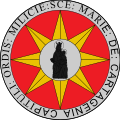 | Order of Saint Mary of Spain | 1270 | | | | | 1280 | Merged into the Order of Santiago. |
 | Order of Montesa | 1317 | | | | | | |
 | Order of the Knights of Our Lord Jesus Christ
( Knights Templar ) | 1317
1917 | | Portugal | | | 1789
1910 | Secularized 1789. |
 | Order of the Dragon | 1408 | Sigismund of Luxemburg | Hungary | | | 1475s | Active throughout the 15th century in the Balkans [28] |
 | Order of Saint Maurice | 1434 | Amedeo VIII of Savoy | Château de Ripaille, Thonon-les-Bains, Savoy | | | 1572 | Merged with the Order of Saint Lazarus in Italy in 1572 by Pope Gregory XIII into Order of Saints Maurice and Lazarus, considered the legitimate successor of both by the ICOC. |
 | Order of the Tower and Sword | 1459 | King Afonso V of Portugal | Portugal | | | | Revived 1808 by Prince Regent John, later John VI of Portugal. Since the end of the monarchy in 1910, all military orders abolished except the Order of the Tower and Sword, with President of Portugal ex officio its Grand Master. |
 | Order of Our Lady of Bethlehem | 1459 | Pope Pius II | Lemnos, Byzantine Empire | 18 January 1459 by Pope Pius II | | 1460 | Founded in 1453 by Pope Pius II after the Fall of Constantinople to the Ottoman Empire, to defend the island of Lemnos, soon recaptured by the Turks, thus rendered useless and suppressed almost as soon as founded. [29] [30] |
 | Order of Saint George of Carinthia | 1469 | Emperor Frederick III, Holy Roman Emperor | | In 1469 by Pope Paul II | | Abolished 26 July 1598
(1732?) | |
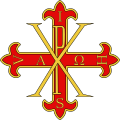 | Sacred Military Constantinian Order of Saint George | 1522–1545
(1520?)(1550?) | Angeli Comneni family | | Addressed in 1550 by Pope Julius III
Cardinal protector in 1910 by Pope Pius X | Decrees by King Philip III of Spain, Ferdinand II, Holy Roman Emperor on 7 November 1630 | | Appears to have been established between 1520 and 1545, with certain statutes dated 1522 by the Angeli Comneni family. Its Grand Master Andrea Angelo Flavio Comneno was addressed first in 1550 by Papal bull Quod Aliasla by Pope Julius III. |
 | Order of Saint Stephen Pope and Martyr | 15 March 1561 | Cosimo I de' Medici, Grand Duke of Tuscany | Tuscany | 1 October 1561 by Pope Pius IV | | | Founded as Benedictine order by Cosimo I de' Medici,. [31] [32] dedicated to the martyred Pope Stephen I and the victories at the Battle of Montemurlo in 1537 and the Battle of Marciano (Scannagallo) in 1554. Fought the Ottoman Turks and pirates in the Mediterranean Sea. Abolished in 1859 by the annexation of Tuscany to the Kingdom of Sardinia. [33] Present, Catholic continuation claimed by Archduke Sigismund, Grand Duke of Tuscany. [34] [35] |



